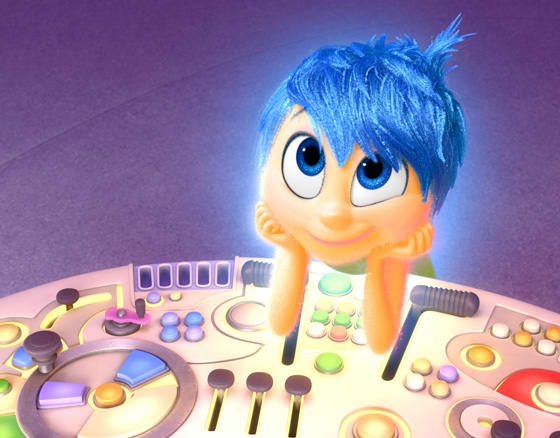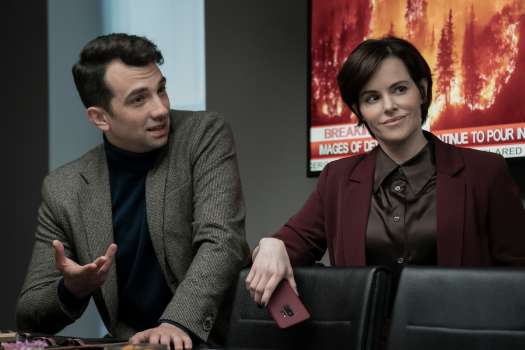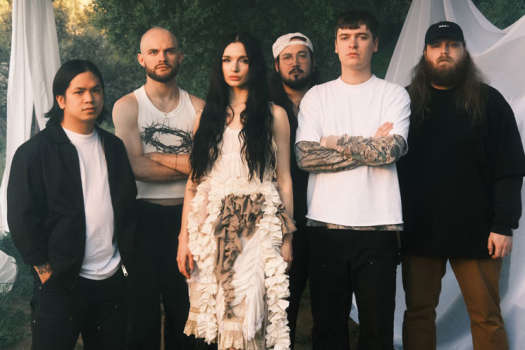Something that the Pixar brand does astonishingly well — particularly with more introspective fare like Wall-E, Up and Toy Story 3 — is explain heartache, disappointment, loss and other contextually complex human experiences to a younger audience without condescension. No exception, Inside Out examines the human experience, a holistic yet accessible perspective, making it feel vital and meaningful. It captures our shared experience in a way that transcends age and other modes of human categorization, understanding the beauty of life without ignoring how difficult it can occasionally be.
In concept, it seems simple enough: when young Riley moves from Minnesota to San Francisco, just preceding the time in life when puberty starts complicating things, her emotional lexicon — here personified by Joy (Amy Poehler), Sadness (Phyllis Smith), Disgust (Mindy Kaling), Fear (Bill Hader) and Anger (Lewis Black) — unravels. But once this playful setup develops this rather complex universe — a universe in which core memories (embodied by coloured balls) shape identity and personality traits are represented by actual islands branching out from memories — it doesn't avoid acknowledging the more philosophical aspects of these ideas.
Initially, Joy acts as commander of Riley's identity. She's always able to access fond or fun memories to cheer Riley up, while playfully bickering with her fellow emotions in a consistently clever and amusing manner. In fact, this interplay — Joy always tries to pep up Sadness who, in turn, finds pleasure in sorrow — is enough to sustain the movie on its own, as they have a natural drive and dialect that propels that narrative forward. Of course, as Riley is challenged by new obstacles and is isolated from her peers, Sadness starts to take more control, tainting the core memories with a new perspective: a perspective of nostalgia and grief.
The eventual journey through Riley's long-term memory, subconscious and imagination is wildly inventive. The visual representations of these psychological concepts is extremely intelligent — they don't refrain from acknowledging pop psychology and the entire gamut of mental minutiae — without skimping on the fun. The idea that the workers in the long-term memory department enjoy repeatedly sending a reminder of a particularly annoying commercial jingle to headquarters just to mess with them is just one example of the many hilarious and witty ways of explaining the function of the human brain. Even secondary comments about opinions and facts — represented by cards — looking far too similar, touch on little insights that keeps an older audience as amused as their child counterparts.
But beyond Inside Out's ability to entertain, it also explores the painful process of maturity. For most of the film, Riley goes through a bout of anger and depression. Here, it's personified by Joy's unplanned departure from the emotional headquarters, but outside of Riley's head, she demonstrates the attributes of many alienated teens. And while it presents as a standard adolescent front in our world, there's an abundance of complication cerebral activity going on behind the scenes — mostly involving the loss of innocence and the shift from childhood imagination to adult imagination — that manages to capture her, and our, inner workings with aplomb.
It's here that Inside Out really shines, being far more involved and comprehensive than most movies made for adults, while having a voice and a mode of storytelling that manages to engage all viewers. This latest Pixar film is a remarkable achievement and may very well be remembered as one of the best, if not the absolute best, of the brand.
(Disney)In concept, it seems simple enough: when young Riley moves from Minnesota to San Francisco, just preceding the time in life when puberty starts complicating things, her emotional lexicon — here personified by Joy (Amy Poehler), Sadness (Phyllis Smith), Disgust (Mindy Kaling), Fear (Bill Hader) and Anger (Lewis Black) — unravels. But once this playful setup develops this rather complex universe — a universe in which core memories (embodied by coloured balls) shape identity and personality traits are represented by actual islands branching out from memories — it doesn't avoid acknowledging the more philosophical aspects of these ideas.
Initially, Joy acts as commander of Riley's identity. She's always able to access fond or fun memories to cheer Riley up, while playfully bickering with her fellow emotions in a consistently clever and amusing manner. In fact, this interplay — Joy always tries to pep up Sadness who, in turn, finds pleasure in sorrow — is enough to sustain the movie on its own, as they have a natural drive and dialect that propels that narrative forward. Of course, as Riley is challenged by new obstacles and is isolated from her peers, Sadness starts to take more control, tainting the core memories with a new perspective: a perspective of nostalgia and grief.
The eventual journey through Riley's long-term memory, subconscious and imagination is wildly inventive. The visual representations of these psychological concepts is extremely intelligent — they don't refrain from acknowledging pop psychology and the entire gamut of mental minutiae — without skimping on the fun. The idea that the workers in the long-term memory department enjoy repeatedly sending a reminder of a particularly annoying commercial jingle to headquarters just to mess with them is just one example of the many hilarious and witty ways of explaining the function of the human brain. Even secondary comments about opinions and facts — represented by cards — looking far too similar, touch on little insights that keeps an older audience as amused as their child counterparts.
But beyond Inside Out's ability to entertain, it also explores the painful process of maturity. For most of the film, Riley goes through a bout of anger and depression. Here, it's personified by Joy's unplanned departure from the emotional headquarters, but outside of Riley's head, she demonstrates the attributes of many alienated teens. And while it presents as a standard adolescent front in our world, there's an abundance of complication cerebral activity going on behind the scenes — mostly involving the loss of innocence and the shift from childhood imagination to adult imagination — that manages to capture her, and our, inner workings with aplomb.
It's here that Inside Out really shines, being far more involved and comprehensive than most movies made for adults, while having a voice and a mode of storytelling that manages to engage all viewers. This latest Pixar film is a remarkable achievement and may very well be remembered as one of the best, if not the absolute best, of the brand.




